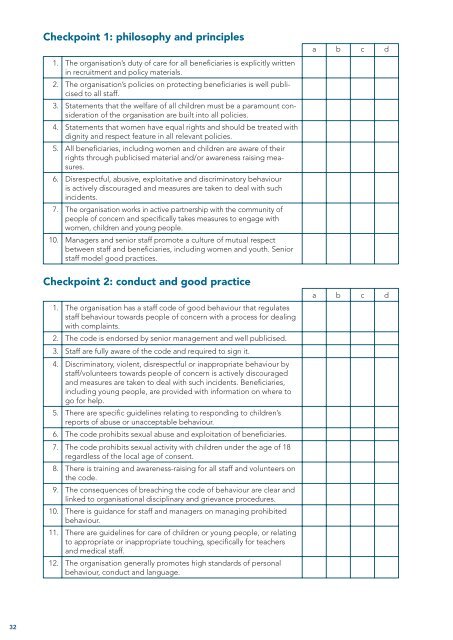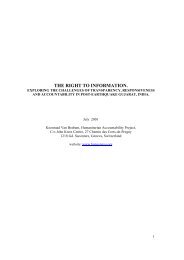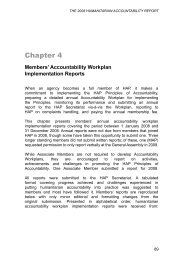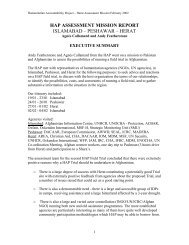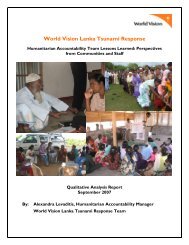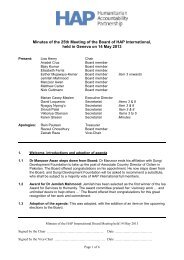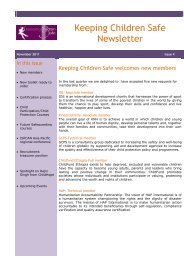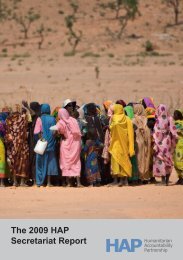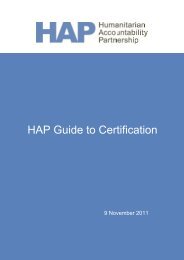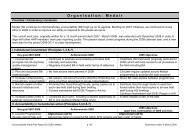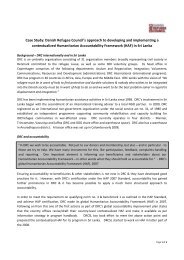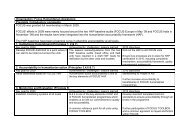Building Safer Organisations Guidelines - HAP International
Building Safer Organisations Guidelines - HAP International
Building Safer Organisations Guidelines - HAP International
Create successful ePaper yourself
Turn your PDF publications into a flip-book with our unique Google optimized e-Paper software.
Checkpoint 1: philosophy and principles<br />
1. The organisation’s duty of care for all beneficiaries is explicitly written<br />
in recruitment and policy materials.<br />
2. The organisation’s policies on protecting beneficiaries is well publicised<br />
to all staff.<br />
3. Statements that the welfare of all children must be a paramount consideration<br />
of the organisation are built into all policies.<br />
4. Statements that women have equal rights and should be treated with<br />
dignity and respect feature in all relevant policies.<br />
5. All beneficiaries, including women and children are aware of their<br />
rights through publicised material and/or awareness raising measures.<br />
6. Disrespectful, abusive, exploitative and discriminatory behaviour<br />
is actively discouraged and measures are taken to deal with such<br />
incidents.<br />
7. The organisation works in active partnership with the community of<br />
people of concern and specifically takes measures to engage with<br />
women, children and young people.<br />
10. Managers and senior staff promote a culture of mutual respect<br />
between staff and beneficiaries, including women and youth. Senior<br />
staff model good practices.<br />
Checkpoint 2: conduct and good practice<br />
1. The organisation has a staff code of good behaviour that regulates<br />
staff behaviour towards people of concern with a process for dealing<br />
with complaints.<br />
2. The code is endorsed by senior management and well publicised.<br />
3. Staff are fully aware of the code and required to sign it.<br />
4. Discriminatory, violent, disrespectful or inappropriate behaviour by<br />
staff/volunteers towards people of concern is actively discouraged<br />
and measures are taken to deal with such incidents. Beneficiaries,<br />
including young people, are provided with information on where to<br />
go for help.<br />
5. There are specific guidelines relating to responding to children’s<br />
reports of abuse or unacceptable behaviour.<br />
6. The code prohibits sexual abuse and exploitation of beneficiaries.<br />
7. The code prohibits sexual activity with children under the age of 18<br />
regardless of the local age of consent.<br />
8. There is training and awareness-raising for all staff and volunteers on<br />
the code.<br />
9. The consequences of breaching the code of behaviour are clear and<br />
linked to organisational disciplinary and grievance procedures.<br />
10. There is guidance for staff and managers on managing prohibited<br />
behaviour.<br />
11. There are guidelines for care of children or young people, or relating<br />
to appropriate or inappropriate touching, specifically for teachers<br />
and medical staff.<br />
12. The organisation generally promotes high standards of personal<br />
behaviour, conduct and language.<br />
a b c d<br />
a b c d<br />
32


